

Whiteboards and dry-erase markers schedule flights just as well as software packages in times of disaster.

In the wake of Hurricane Irene, Bahamas Habitat quickly mobilized volunteer pilots to fly supplies to the islands.
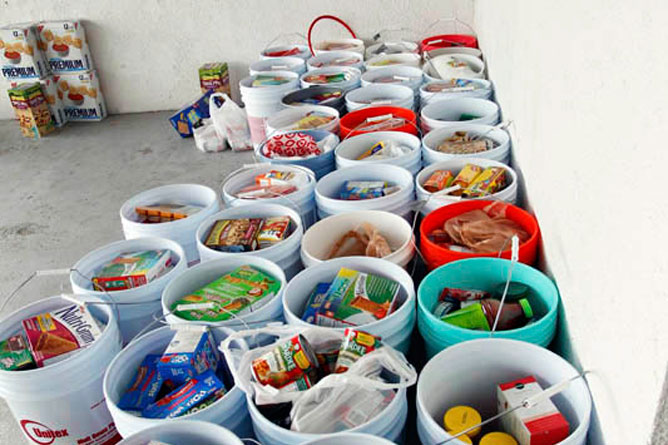
Five-gallon buckets carry critical food supplies to the island and then double as a clean-up tool.
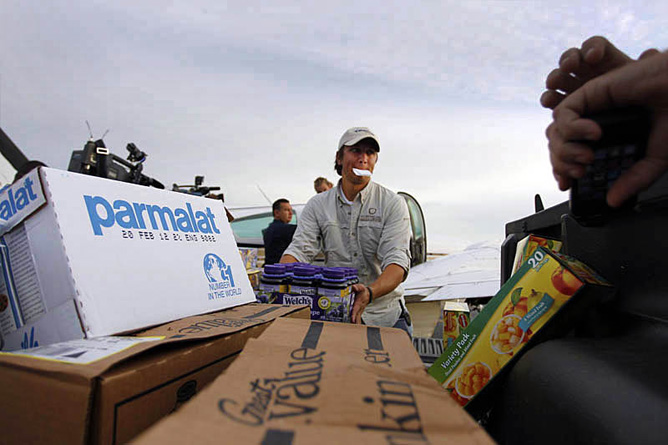
"This'll be gorgeous."—Cary Farrington, volunteer dispatcher, on perfect timing. A Baron loaded with 1,000 pounds of supplies will land just 20 minutes before a Bonanza takes the items to the islands.

"I'm playing Tetris!"—Addison Shock, volunteer, filling every open inch of Baron. He knows the weight of each pack of peanut butter, chicken, and Vienna sausages.
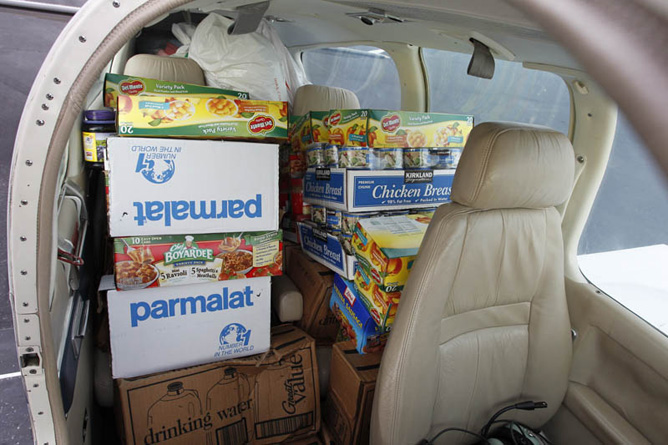
Precious cargo. If a relief volunteer isn't filling a seat, that space is designated for food, water, and shelter supplies.

"It's been such an incredible blessing the way people come together."—Sarah Stewart, a volunteer at the makeshift command center at Banyan Air Service.

"People are getting fed. This is the way it works."—Cameron King, Bahamas Habitat Aviation and Disaster Relief Coordinator.

"Don't let go. I thought you were going to blow away."—Cameron King to her friend Deatra Symonette at Exuma International Airport.

"It's going to take a whole lot more than Irene to knock us down."—Deatra Symonette, Odyssey Aviation station manager.
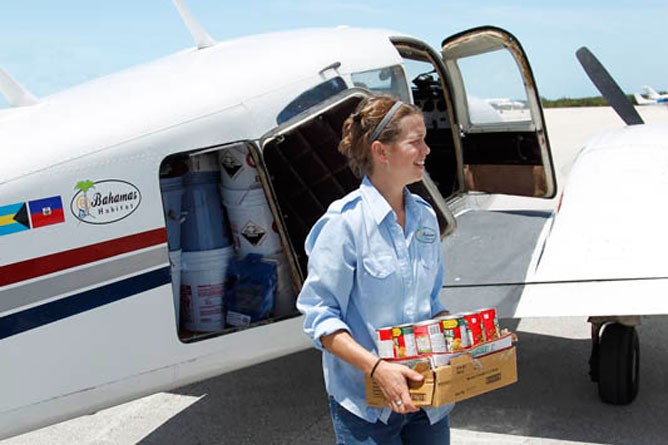
Pilot, coordinator, food handler, relationship builder … Cameron King wears many hats during disaster relief flights to the Bahamas Islands.

Relief supplies crammed into this Baron are headed to Cat and Eleuthera islands.
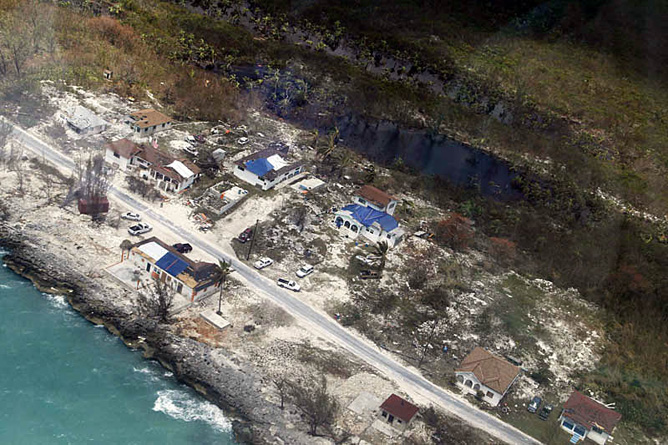
Blue tarps are tell-tale signs of hurricane damage.

"Liquid gold."—Brian "Cowboy" Ferguson's (in the fishing hat) term for drinking water.

"It's a lot of work. It's a lot of fun."—David Robertson, volunteer pilot.

Cat Island residents move their laundry and furniture out into the hot sun to dry from the hurricane damage.
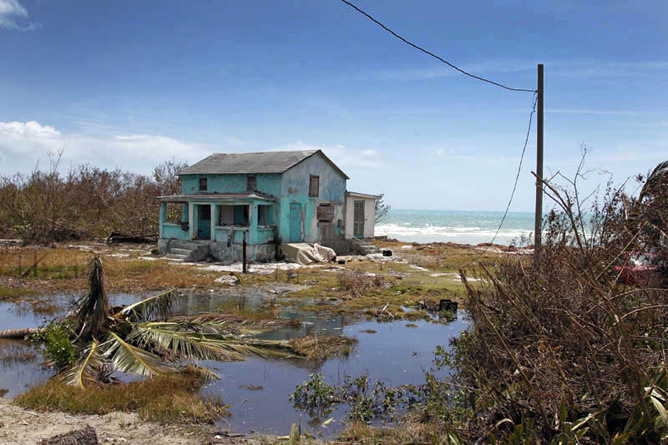
Storm surges washed through houses near the coast on Cat Island.

Children help unload and sort relief supplies that will be handed out by Great Bethel Methodist Church.
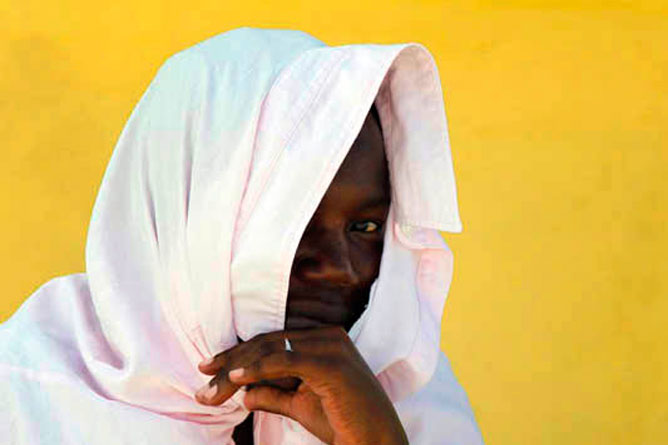
A Bahamian shields herself from the heat at Arthur's Town Airport on Cat Island while awaiting supplies from Florida.

Partners for a day. Volunteer pilot David Robertson of Cullman, Ala., and Calvary Chapel staff member Jason Mann of Fort Lauderdale team up to unload supplies.

A Piper PA-23-250 at Governors Harbour International Airport flipped over the perimeter fence, both engines torn from the aircraft, and the fuselage cut in half.

Young men erect one side of a room that collapsed in the hurricane.

Young men erect one side of a room that collapsed in the hurricane.
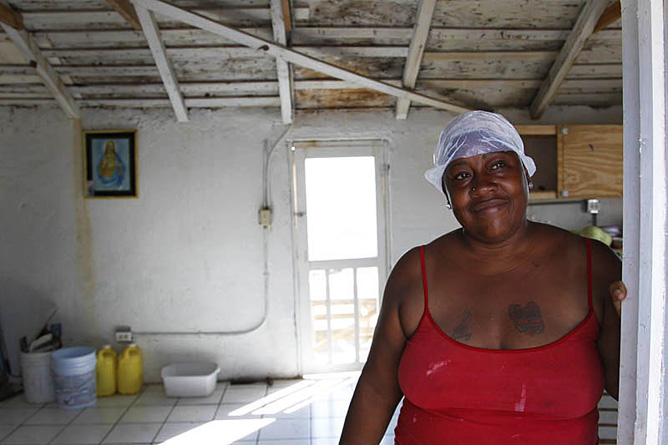
"The sea came straight through."—Diana Demeritte of Cupid's Cay who lost everything in her house.
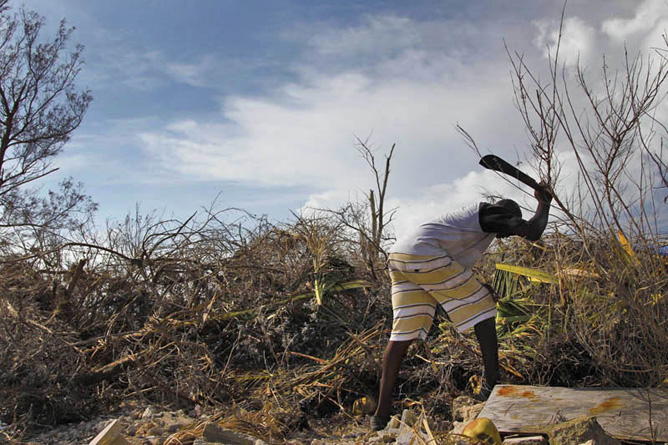
Clearing debris. The storm uprooted and twisted trees on many of the islands, knocking down power lines and blocking roads.

"I've gotta sleep on the floor."—Sharon Johnson, who has lived in Cupid's Cay her entire life.

This nonagenarian weathered Irene without much damage, but his neighbors' homes were nearly destroyed.

Shingles and entire roofs were blown away on Cat Island. Temporary tarps provide shelter, but residents worry that a new storm could brew before needed repairs are complete.
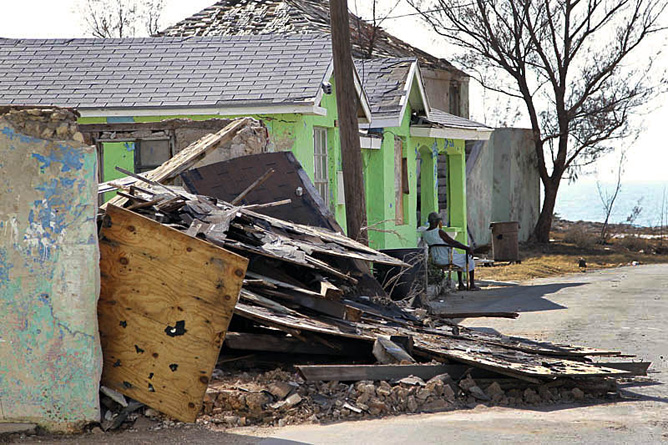
Weakened structures simply succumb to Hurricane Irene's wind, rain, and storm surge.
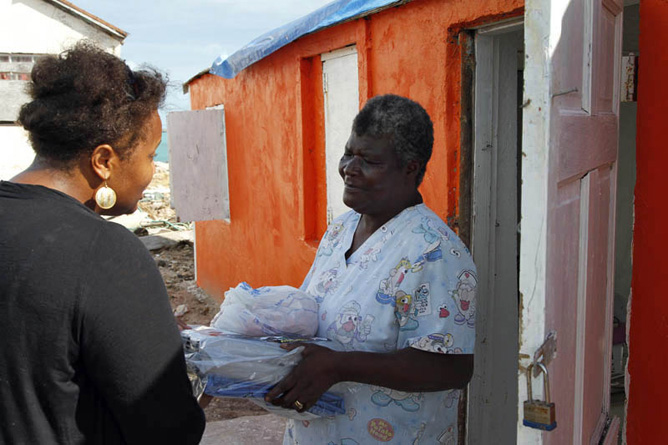
Heavy duty tarps will help provide shelter for Sharon Johnson. A section of her home collapsed; her furniture, mattress, and appliances were destroyed.

A playful puppy's contagious energy brings smiles to weary residents on Cupid's Cay.
Looking out over the turquoise Caribbean Sea from Cat Island seems like paradise. But look left, right, or inland across the street and it looks as if something exploded. Trees are twisted and uprooted, asphalt washed off the street like tar paper, mattresses and furniture piled in heaps, sides of home collapsed or missing. Hurricane Irene pummeled parts of the Bahamas Islands, and general aviation pilots are working to provide food, water, and shelter to those in need.
A distant whir quickly grows to a roar as a red and blue Aztec buzzes the Cat Island coastline after takeoff, its two 250-horsepower Lycoming IO-540 engines at full power. All conversation stops; necks crane skyward to follow the Aztec’s path. No one grumbles about the interruption. That Aztec is one of the Bahamians’ sources of hope—and survival. It’s a signal that the pilot just dropped off food, water, and construction tools at the Arthur’s Town Airfield.
The aircraft is one of 20, ranging from a Cessna 182 to a King Air 350, involved in the Bahamas Habitat Hurricane Irene disaster relief effort. Pilots from as far away as California have donated their time and aircraft to deliver supplies from Florida’s Fort Lauderdale Executive Airport to the Bahamas. These flights through Bahamas Habitat are some of the first to reach the islands, including remote areas on Cat, Eleuthera, and Acklins, delivering 25,225 pounds of relief supplies. The Bahamians survived the Category 3 hurricane without any fatalities, according to news reports, but how long could they survive without food, drinking water, or their homes? Many docks were damaged or destroyed, leaving residents wondering if ships would be able to dock in a few days when they were scheduled to arrive with supplies. None of those worries exists with general aviation. The airports are first to open, and reconnaissance and relief flights started the day after the hurricane hit.
“That can really matter. That can really make a difference,” Cameron King, Bahamas Habitat aviation and disaster relief coordinator, said of the importance of using GA for ministry and relief efforts in the Bahamas.
Some houses on Acklins Island were completely washed away. All that remained of other houses on the island chain were shells: Everything inside was washed away by a storm surge or flooded when roofs and shingles blew away, exposing living areas to the hurricane’s torrential downpours. Meanwhile, other homes escaped unscathed as if the storm handpicked which to spare.
Diana Demeritte wasn’t so fortunate. Her tiny abode overlooking the Caribbean’s turquoise waters from a 10- to 20-foot rocky ledge at Cupid’s Cay filled with water waist deep from the storm. “You don’t know if it’s just going to come and make one wash,” sweeping everything away, Demeritte said of the surge. She waded through the waist-deep water to a friend’s house to sleep on the floor for the night. By Tuesday, she had cleaned out much of the inside of her house, which was mostly empty except for a pile of shoes ruined by the seawater. She had two gallons of drinking water and some food. She tried to buy a gas canister for her single-burner stove, but the store was out. Perhaps a candle for light? Out of that too.
“We need help, we really need help,” Demeritte said. She’s trying to pick up the pieces, but more than her material loss weighs on her heart. Her husband of seven years died in March, she said, holding up a black-and-white picture of him photocopied onto a booklet that she somehow kept mostly dry. Demeritte doesn’t have a job right now either.
“It’s nice to live here when there’s no storm,” Demeritte said matter-of-factly as she walked across her rocky backyard to overlook the water. “When you have a storm, it’s hard. You lose everything and have to start again.”
And they are starting again. “It’s going to take a whole lot more than Irene to knock us down,” said Deatra Symonette, Odyssey Aviation station manager at Great Exuma Island. Other Bahamians have that same attitude. They’ve lived through many hurricanes; Irene won’t be the last, they pointed out as talk turned to more storms brewing in the Atlantic. Residents in their 60s and 80s alike agreed that this was the worst they had experienced. Some doubt reports that the hurricane was only a Category 3.
It’s people like Demeritte, or the single woman whose refrigerator was pushed out of her house and across the street by the storm surge, or the many who are sleeping on floors that the volunteers have in mind when they get up in the wee hours to get started by daylight. Normal arrival time: 6:45 a.m. Any aircraft that aren’t already loaded with supplies from the night before get stuffed to the brim.
“Woo, it’s a pretty day. Here we go,” exclaims volunteer Addison Shock, program director for Servants in Faith and Technology, a Christian organization that teams with Bahamas Habitat. He has no aviation experience but has learned the finer points of weight and balance. He knows he can load 1,000 pounds into a Baron that morning and that it’s about the equivalent of a full Dodge Silverado truck bed. A box of Vienna sausages weighs five pounds; packs of Jif peanut butter weigh 20 pounds. He uses the weight listed on the containers or a rusty set of scales in the T-hangar where supplies are stored. Then he has the challenge of bending his 6-foot, 4-inch frame into the aircraft to load it. Heavier items toward the front, lighter ones near the back. “I’m playing Tetris,” he says, refusing one item and requesting Vienna sausages to fit an exact hole.
While Shock is loading David Robertson’s Baron, Robertson is inside Banyan Air Services planning his missions for the day with King. They’ll be flying a Baron and Aztec to Great Exuma Island to clear Bahamian Customs and then deliver supplies to Arthur’s Town Airfield on Cat Island and Governors Harbour on Eleuthera Island. They’ll be surveying damage with a staff member Jason Mann from Calvary Chapel, which is located just beside Fort Lauderdale Executive Airport. The church already had donated four pallets filled with tarps, some generators, food, and water. Mann will be assessing where short-term construction teams from his church could be most effective.
With flight plans and Customs and Border Protection’s Electronic Advance Passenger Information System manifests filed, the airplanes loaded and fueled, and the pilots’ and passengers’ bladders empty, the group sets out. In cruise, King adjusts the Aztec’s rpm and manifold pressure to reach 160 knots, or what Bahamas Habitat Chief Pilot Steve Merritt calls V BH, “Be Happy speed.” She briefs her passengers on the day’s mission while naming each island the group passes. The turquoise Caribbean waters are still a little rougher than usual, according to the locals, but they’ve returned to their brilliant hue that fair-weather cumulus clouds reflect. “It looks like cotton candy suspended in air,” King says of the blue-green clouds.
After a bumpy final approach from the winds and heating of the day, King touches down lightly at Great Exuma. “Welcome to the Bahamas,” she says. She can’t wait to shut down. She’s looking for a friend on her first trip to the island since the hurricane.
“Don’t let go. I thought you were going to blow away,” King tells Symonette while they embrace. Symonette is one of the many King will check in on that day.
King, who lived on Eleuthera Island for 10 months and flies to the Bahamas every month for different missions to support partner organization Bahamas Methodist Habitat, has developed many close friendships. Although she now lives in Knoxville, Tenn., she keeps in close contact with her friends on the monthly trips. She called many of them before the storm hit. One began to say goodbye in case she didn’t survive the hurricane, King recalls, pausing to catch her voice. King promised she’d check in after the hurricane and would be there with supplies as soon as possible.
“I could barely sleep,” King says of the night the hurricane hit the islands. Once the storm passed, Bahamas Habitat immediately assessed reports coming from the island to determine if relief efforts were needed. The group won’t fly into an area unless a disaster response is warranted. King kept her promise to her friend, who made it through the hurricane, flying a reconnaissance mission over the islands the very next day after the hurricane. King led mobilization efforts to get pilots in the area to fly supplies. During her first opportunity to fly to the islands herself, she stopped in to deliver supplies while also assessing the damage to determine where to concentrate the group’s efforts.
Other volunteer pilots also have developed attachments to the Bahamians. King says it’s face-to-face time with the residents—whether at the airport while unloading supplies or working with them during short trips off the airport—that keeps volunteer pilots coming back. When disaster strikes the Caribbean, it’s no longer about a foreign chain of islands off the Florida coast. It’s about the woman, man, or child the pilot met at the airport.
A typical day of missions takes at least five hours of flying. Many volunteer pilots aren’t from the area, including two pilots flying an Aztec and Baron from Cullman, Ala., a Twin Comanche pilot from North Carolina, and Mooney aviator from California.
Their days stretch to 12 hours, including filing eAPIS manifests, flight planning, clearing Bahamian and U.S. customs, and loading and unloading aircraft. The pilots are on the ground in the islands only long enough to unload supplies in 90-degree heat and what feels like 90 percent humidity. In many cases they directly hand the supplies to the Bahamas Habitat contacts who will deliver them to those in need.
Pilots volunteer their time and aircraft, pay for their own lodging and fuel (for themselves and their aircraft). However, pilots submit their claims of tax-deductible expenses to Bahamas Habitat and the organization documents them and provides receipts, according John Armstrong, president of Bahamas Habitiat. Avgas is more than $7 a gallon on the islands.
Bahamas Habitat is able to work around political problems that can tie up relief delivery by maintaining close contacts on the island. King’s time living on and frequent trips to Eleuthera Island help her maintain and build new relationships with airport employees and residents on the islands, and she can check in on the disaster relief efforts and long-term sustainable development programs.
Flying in these demanding conditions is strenuous. Two pilots helping with the Bahamas relief effort have flown many Haiti relief missions with Bahamas Habitat and know the tricks for maximizing efficiency and taking care of themselves. Others also flew missions to Haiti through other organizations. They keep a small snack bag and extra water in the aircraft to stay hydrated. The beauty of the Caribbean waters provides excellent views and the desire to help those suffering on the ground is strong, but these pilots focus on their purpose.
“They don’t need me out there,” said Scott Brallier with Wings for the Word, who had been flying missions in a Twin Comanche from Fort Lauderdale to Cat and Eleuthera islands. “They need what I can bring.”
Despite being set back by the economic slump, aviation businesses are pulling together to donate supplies or fly missions with Bahamas Habitat. Banyan Air Services helped support Bahamas Habitat and its volunteer pilots. Bahamas Elite flew reconnaissance missions after Hurricane Irene, Angel Flight Southeast pilots participated, as well as pilots from PilotMall.com, Air Journey, and Premier Aircraft Sales.
Neil Glazer, owner of PilotMall.com, flew his Mooney from California to Florida to meet up with Air Journey’s Guillaume Fabry for relief flights. Because of a mechanical issue with his Mooney, Glazer flew with Fabry in a Baron instead of both aircraft going. Premier Aircraft Sales founder Fred Ahles has flown a mission, and his wife, Catherine, has helped gather many of the supplies pilots are delivering.
Pilots can see the difference they are making, too—from the air. “You can tell which way the hurricane winds were blowing,” Robertson said. Blue tarps they are delivering dot houses that sustained roof damage along the coasts. Catherine helped shop for survival supplies. Even though she stayed stateside, she has no question about the impact Bahamas Habitat is making.
“That’s [a] niche Bahamas Habitat has filled,” Catherine said of serving rural areas of the islands. “Those people wouldn’t get help otherwise. Bottom line.”
Intro | Flight for survival | 'Don't let go' | Mission ready | "Boots on the Ground" Blog entry


